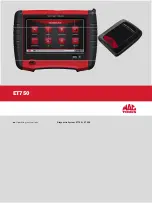
6 Transesophageal T ransducer
Instructions for Use
6 - 35
Preventing Injury and Equipment Damage
Following the preventive measures outlined below will help ensure patient safety.
Preventive Measure
Problem
Potential Harm to
Patient/Potential Damage
Place both V5Ms flex controls in the neutral
alignment position, without the friction
brakes applied, when you insert or withdraw
it. Do not force the transducer.
Improper insertion or
withdrawal
Esophageal cuts, bruising, bleeding,
ligament damage, perforations
Place the V7M flex control in the neutral
alignment position, without the friction brake
applied, when you insert or withdraw it. Do
not force the transducer.
Improper insertion or
withdrawal
Esophageal cuts, bruising, bleeding,
ligament damage, perforations
Inspect the transesophageal transducer prior
to each use to ensure that it is functioning
properly and that it has no cuts, tears,
fraying, loose parts, or rough edges.
Mechanical damage,
electrical damage,
leakage current
Severe trauma, esophageal cuts,
bleeding, perforation, electrical burns,
serious electrical hazards
Use only isolated output electrosurgical units
with the transesophageal transducer.
Disconnect the transducer when it is not
in use.
Non-isolated electrosurgical
units
Electrical burns
Adjust the Transmit Voltage (dB or %) as
low as clinically useful. Observe the
on-screen temperature warning messages
and respond accordingly.
Improper transducer
temperature and/or acoustic
output
Esophageal burns
For maximum safety, disconnect the
transesophageal transducer from the system
prior to defibrillation rather than relying on
the transducer's built-in safeguards.
Defibrillation
Electrical burns
Maintain a regimen of electrical safety
checks.
Electrical damage,
leakage current
Esophageal burns, electrical damage
Put the transducer in the neutral position,
without either friction brake applied, when
inserting or withdrawing it. Minimize
pressure applied to the articulating section
and distal tip. Do not let the distal tip
displace tissue for more than five minutes.
Pressure necrosis
Permanent damage to esophageal lining
Summary of Contents for Acuson S2000
Page 12: ...1 Introduction 1 2 Instructions for Use ...
Page 14: ...1 Introduction 1 4 Instructions for Use System Review Example of the ultrasound system ...
Page 84: ...2 Safety and Care 2 54 Instructions for Use ...
Page 86: ...3 System Setup 3 2 Instructions for Use ...
Page 112: ...3 System Setup 3 28 Instructions for Use ...
Page 114: ...4 Examination Fundamentals 4 2 Instructions for Use ...
Page 144: ...5 Transducer Accessories and Biopsy 5 2 Instructions for Use ...
Page 196: ...7 Specialty Transducers 7 2 Instructions for Use ...
Page 200: ...7 Specialty Transducers 7 6 Instructions for Use ...
Page 202: ...8 Physiologic Function 8 2 Instructions for Use ...
Page 208: ...9 eSieFusion Imaging 9 2 Instructions for Use ...
Page 236: ...10 Virtual Touch Applications 10 2 Instructions for Use ...
Page 258: ...10 Virtual Touch Applications 10 24 Instructions for Use ...
Page 302: ...Appendix A Technical Description A 44 Instructions for Use ...
Page 326: ...Appendix B Control Panel and Touch Screen B 24 Instructions for Use ...
Page 328: ...Appendix C Control Panel C 2 Instructions for Use ...
Page 394: ...Appendix D On screen Controls D 50 Instructions for Use ...
Page 444: ...Appendix F Acoustic Output Reference F 2 Instructions for Use ...
Page 516: ...Appendix F Acoustic Output Reference F 74 Instructions for Use ...
Page 517: ......
Page 518: ......
















































